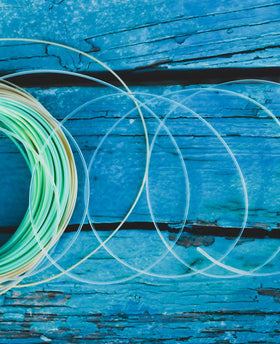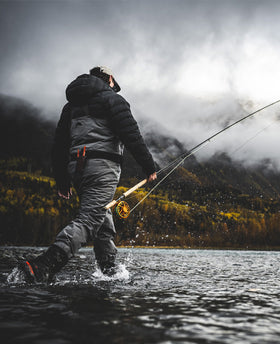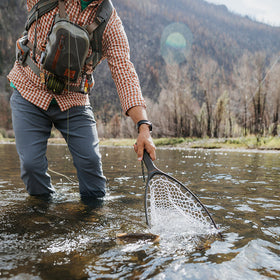
Streamer Fishing: Extra Credit
Our past three installments from our Streamer Fishing “classes” have focused on techniques, gear, presentations, and fly types. This is just about everything you need to know without getting too crazy with things. We hope that these tricks and tips helped you out and got you onto some fish, or in the near future. Moving forward, we’re going to get into the “Extra Credit” of the Streamer Fishing classes. We promise though, we won’t be making you do any work to pass this class. Instead, we just want to talk about each one of our favorite pieces of gear, flies, approaches, etc. We will also take a small dive into some additional tips that will increase your success when you’re out on the water. So without further ado:
Our Favorite Setups, Flies, and Tactics:
Xavier:
 For smaller rivers that I’m wading, or barely squeaking a raft through, I prefer to fish a 9’ 6wt Sage R8 Core. The lighter weight rod allows me to effectively throw the smaller streamers that are necessary to fish these waters. In rivers like these, I like to fish with a Scientific Anglers Amplitude Textured MPX. I find the sinking lines in skinny water have very few benefits, as they usually spook fish when hitting the water and sink the fly too deep. I can get away with fishing the floating line with a splitshot or two, and in my opinion, fish the skinnier water more effectively than I could with a sinking line.
For smaller rivers that I’m wading, or barely squeaking a raft through, I prefer to fish a 9’ 6wt Sage R8 Core. The lighter weight rod allows me to effectively throw the smaller streamers that are necessary to fish these waters. In rivers like these, I like to fish with a Scientific Anglers Amplitude Textured MPX. I find the sinking lines in skinny water have very few benefits, as they usually spook fish when hitting the water and sink the fly too deep. I can get away with fishing the floating line with a splitshot or two, and in my opinion, fish the skinnier water more effectively than I could with a sinking line.
For all my other river streamer fishing, I like the Hardy Ultralite X 9’ 8wt paired up with a Scientific Anglers Sink 25 Cold 300 grain. I feel that the 8wt can handle just about anything I throw on the larger side of things, and the Ultralite X’s fast action with its abbreviated fighting butt makes it the best streamer tool out there (to me). I prefer this fly line over others because I’ve found it handles the best when casting due to its uniform head. Tungsten sinking lines don’t behave the same as floating lines, so different tapers between the two react differently. Uniform tapers aren’t good for floating lines, but due to the heaviness of a sinking line it’s the only way to go without breaking your arm.
For my streamer reels, I just use a Lamson Litespeed F 7+ for both rods as they balance out well. My streamer leaders are incredibly simple, the only materials I use are 15lb and 20lb fluorocarbon with a barrel swivel separating the two. My floating line leaders are 3ft of 20lb, barrel swivel, and 3ft of 15lb. Whereas my sinking line leader is 1ft 20lb, barrel swivel, and 2ft 15lb. My favorite flies to fish are some home ties, Mini Boogeyman, Montana Humdinger, Peanut Envy, and Mini Dragon Bond.
When I’m fishing with big meat, I try to fish every single approach I can to see what the fish are wanting. Ideally though, I prefer to fish upstream from the bank to elicit a predatory response from the trout I’m targeting. Fish that are looking to actually eat your fly, and not just attack it are the best out there. They’re looking to eat a giant meal and they’ll do just about anything to get it.
Tryston:
 I like to fish 7wts when streamer fishing because it allows me to fish any type of scenario and streamer I need for the rivers I fish. I do, however, like to fish different 7wts for different applications. When I’m floating, wade fishing bigger rivers, or bigger flies, I like to fish an Orvis Helios 3D with a Hatch Iconic 7+ and Rio Elite Predator S3/5/7. The Helios is a fast rod that can handle just about everything I throw at it, but I really like this rod for the scenarios because of its ability to handle a sinking line with ease. When I know I’m going to be fishing skinnier water or on a stillwater, I like to fish the Sage Salt R8 with a Sage Arbor XL 6/7/8 and the Scientific Anglers Sonar Stillwater Camo. The Salt R8 is a fast rod, but its flex comes from its middle section which allows for it to power through the wind, but at the same time be relatively gentle. This type of flex pairs up very well with a more delicate presentation such as an intermediate line. The goal with this presentation isn’t to hit the bottom, but to break that surface current that the floating line can’t.
I like to fish 7wts when streamer fishing because it allows me to fish any type of scenario and streamer I need for the rivers I fish. I do, however, like to fish different 7wts for different applications. When I’m floating, wade fishing bigger rivers, or bigger flies, I like to fish an Orvis Helios 3D with a Hatch Iconic 7+ and Rio Elite Predator S3/5/7. The Helios is a fast rod that can handle just about everything I throw at it, but I really like this rod for the scenarios because of its ability to handle a sinking line with ease. When I know I’m going to be fishing skinnier water or on a stillwater, I like to fish the Sage Salt R8 with a Sage Arbor XL 6/7/8 and the Scientific Anglers Sonar Stillwater Camo. The Salt R8 is a fast rod, but its flex comes from its middle section which allows for it to power through the wind, but at the same time be relatively gentle. This type of flex pairs up very well with a more delicate presentation such as an intermediate line. The goal with this presentation isn’t to hit the bottom, but to break that surface current that the floating line can’t.
My leader formula is also pretty simple, for all streamer fishing purposes I like to use a leader consisting of 1ft of 25lb fluorocarbon and 4ft of 20lb fluorocarbon with a blood knot connecting the two sections. My favorite flies to throw are the Mini Dungeon, Kreelex, Drunk and Disorderly, and the Cheech Leech.
I’ll fish streamers just about any way and anywhere I can, but if I had to pick, I’d like to fish from a boat. It allows me to cover so much water and so many fish that I feel like my odds are truly in my favor. Ideally, I’m pounding the banks as I’m floating, but I will also swing my fly to see if they want a slower moving presentation.
Some Additional Tips:

Matching The Food Source:
This is something that I feel like most people tend to overlook when tossing streamers. Most people like to throw on a fly that their buddy recommended to them, a color they really like, or a fly that caught them fish the last time they were out. I can attest to the statement that confidence is key, but you aren’t going to throw a size 6 rubberlegs during a BWO hatch are you?? So why would you throw a baby rainbow pattern that your buddy swears by in a river with no rainbows? I will note before going into this, that yes the color doesn’t really matter that much. I’ve made that very clear. But if you’re really trying to increase your odds at catching a giant fish, you need everything that you can control in your favor.
Matching the food source that the fish regularly predate on is the best way to go. Sculpins live in just about every river in Colorado, so tossing a sculpin pattern is never a bad choice. Obviously, adjusting your sizing and coloration will vary depending on the conditions. They can be fished at just about any time of the year, but the best time I’ve found is during the spring when the sculpin are spawning. They come out from the regular hiding holes and are more available for the trout to prey on. It’s hard for trout to pass up a free swimming sculpin because they aren’t necessarily the best swimmers once they leave the bottom of the river.
Post run-off it seems like the food preferences take a shift. The sculpin are done spawning and are hanging out in their boulders again. But, with the receding water comes hatching fish of every kind. Baby trout, whitefish, and suckers are everywhere. Predatory trout definitely take note of this and will switch their focus to these food items. Crawdads, crawfish, crayfish, whatever you want to call them will also be on the menu. Warmer water conditions makes these crustaceans more active, thus making them more susceptible to predation. There’s a limited timeframe on these food sources though because once flows drop, predatory trout are much more hesitant on eating bigger meals.
Once the post run-off timeframe ends the water is low and clear, which is advantageous for prey items. They aren’t forced to sit in slightly faster currents and can now spot predators from a mile away. Predatory trout know that this isn’t the time to waste energy on food sources that are likely to escape before they pounce. This is the best time to switch to smaller offerings, particularly leeches and other flies in that 1-3 inch range. This same tactic can be used throughout the fall, as flows are generally low and only getting lower.
That said, the fall is a great time to move back to bigger baitfish flies. As mentioned in earlier blogs, the fall is where big trout are getting aggressive from their spawn, but also putting on some weight for the winter. So even though the big flies are counter intuitive to the water conditions, they flat out work. This can also be applied to winter fishing in rivers that don’t freeze over. Water temperatures are super low and fish aren’t trying to waste energy on unnecessary smaller meals. Why burn a ton of energy chasing down a tiny streamer? The caloric payoff is minimal. But, if one of these fish decides to burn some energy on a moving prey item, they’re going to do so when the offering is large. The caloric payoff for them is absolutely worth it, so fish those big baitfish flies throughout the winter.
Be Ready To Commit:
The one thing I notice with those who throw streamers occasionally is they give up far too quickly. They’ll toss it out there for only an hour and then put it away for the rest of the day. The stretch of river that was fished may not have had actively feeding fish and putting the rod down prematurely may have cost the fish you were looking for. There are times where I’ve fished for 6-7 hours with no bites and suddenly the last bit of the day had nonstop action. I would’ve never found this action had I not kept fishing the streamer. It can take all day to find those fish, it could take multiple days even. The biggest thing is sticking with it and not putting that streamer rod down. If you’re looking for that instant success or a ton of fish netted, don’t streamer fish. Big fish aren’t always out on the hunt, but being out there and fishing the streamer as much as possible will increase your odds. Stick with it, fish hard, and always present each cast like a fish is actively hunting it.
This is the conclusion to the streamer fishing series and we hope it helped everyone out and gain some streamer knowledge. If you have any questions, as always you can reach out to Xavier via email at xavier@goldenflyshop.com, or call the shop at 303-330-1292. Thank you!






Leave a comment